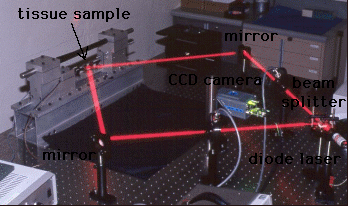
http://www.sharplan.com/greenyag.htm
NewsEtc, September, 1998. Steven Jacques, Oregon Medical Laser Center
This month we emphasize laser beams.
The idea this month was to collect images of laser beams from the WEB. It proved to be suprisingly difficult to find interesting images of laser beams. Most laser companies just show laser equipment, or the very few laser beams shown were not too interesting. The following images are not all from biomedical applications. If you find any good laser beam images, please let me know.
 http://www.sharplan.com/greenyag.htm | The doubled Nd:YAG laserconsists of 1064-nm infrared laser pulses (about 10-ns pulse duration at 5-10 kHz repetition rate) which are converted by crystal (eg., KTP crystal) via second-harmonic generation to the next harmonic which is 532 nm, a green light. The laser is used in surgical applications to cut or vaporize tissue, or achieve thermal coagulation. |
 image link image linkLaser speckle measurement of biomaterials strain in response to applied stress. A diode laser is split into two beams which converge from opposite angles onto a sample held in a device with a piezoelectric transducer that cyclically strains the tissue on the order of µm's. The speckle patterns are caused by interference of photons scattered by the sample. The phases of photons are sensitive to the photon paths in the tissue, hence the speckle patterns are modulated by the strain caused by the piezoelectric transducer. Analysis of the speckle movements yields well-defined strain values. The method is a variation of the well-known method using a single laser beam normal to the tissue and two imaging camaeras. In this case, two beams and a single camera are used, with analysis by a transform method similar to [Duncan, Kirkpatrick, et al., 1994]. Sean Kirkpatrick, Dept. of Biomaterials and Biomechanics, School of Dentistry, Oregon Health Sciences University. Sean's home page | The diode laseris a solid-state device which lases to emit a deep red to near-infrared laser beam. A common example is the laser pointer. Recent work (see article) has used conjugate mirrors to improve the wavelength stability, collimation and coherence of diode lasers. In this figure, a 809-nm diode laser is being used to conduct laser speckle measurements of biomaterials strain in response to applied stress, studying mechanical properties of bone, atherosclerotic plaque, skin, and other biomaterials. |
 http://www.lmw.uni-bayreuth.de/mikro/LMW-CVL.html | The copper vapor laseris a powerful continuous laser which has found industrial uses cutting and marking materials, as shown in this image. The copper vapor laser has found some uses in thermal coagulation therapy of vascular cutaneous lesions. |
 http://www.laserium.com/gallery/gallery.html | Various ion lasers, doubled YAG lasers, and dye lasersare used to create a variety of colors for laser shows. This image shows one such light effect for entertainment. |